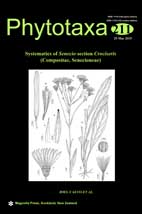Abstract
The complexity of the evolutionary history of Senecio is reflected in its conflicted taxonomy. Within this genus, Senecio section Crociseris (Compositae, Senecioneae), a group of perennial herbs distributed in Europe, western and Central Asia, and northwestern Africa, was not fully revised. A worldwide revision of this section recognizing 28 species and eight subspecies is presented here. The main morphological characters revealed as useful for distinguishing between species are the number and shape of supplementary and involucral bracts, synflorescence architecture, indumentum, and the shape and size of leaves and achenes. In this new taxonomic treatment S. provincialis and S. lagascanus have been segregated from S. doronicum, within which three subspecies are recognized (S. doronicum subsp. orientalis is validly published herein). On the other hand, S. ruthenensis from France and S. lusitanicus from Portugal have been synonymized to S. lagascanus, as well as S. ovatifolius, S. pisidicus, and S. tmoleus from Anatolia to S. kolenatianus, S. olympicus, and S. castagneanus respectively, S. bertramii from Lebanon to S. cilicius, and S. delbesianus from Syria to S. racemosus subsp. racemosus. Sixty eight names are lectotypified, the names S. barrelieri, S. pyrenaicus, and S. scopolii are neotypified, and one epitype is designated for the name S. perralderianus. Descriptions and distribution maps are provided for all the species included, as well as an identification key. Nine species are illustrated for the first time.

